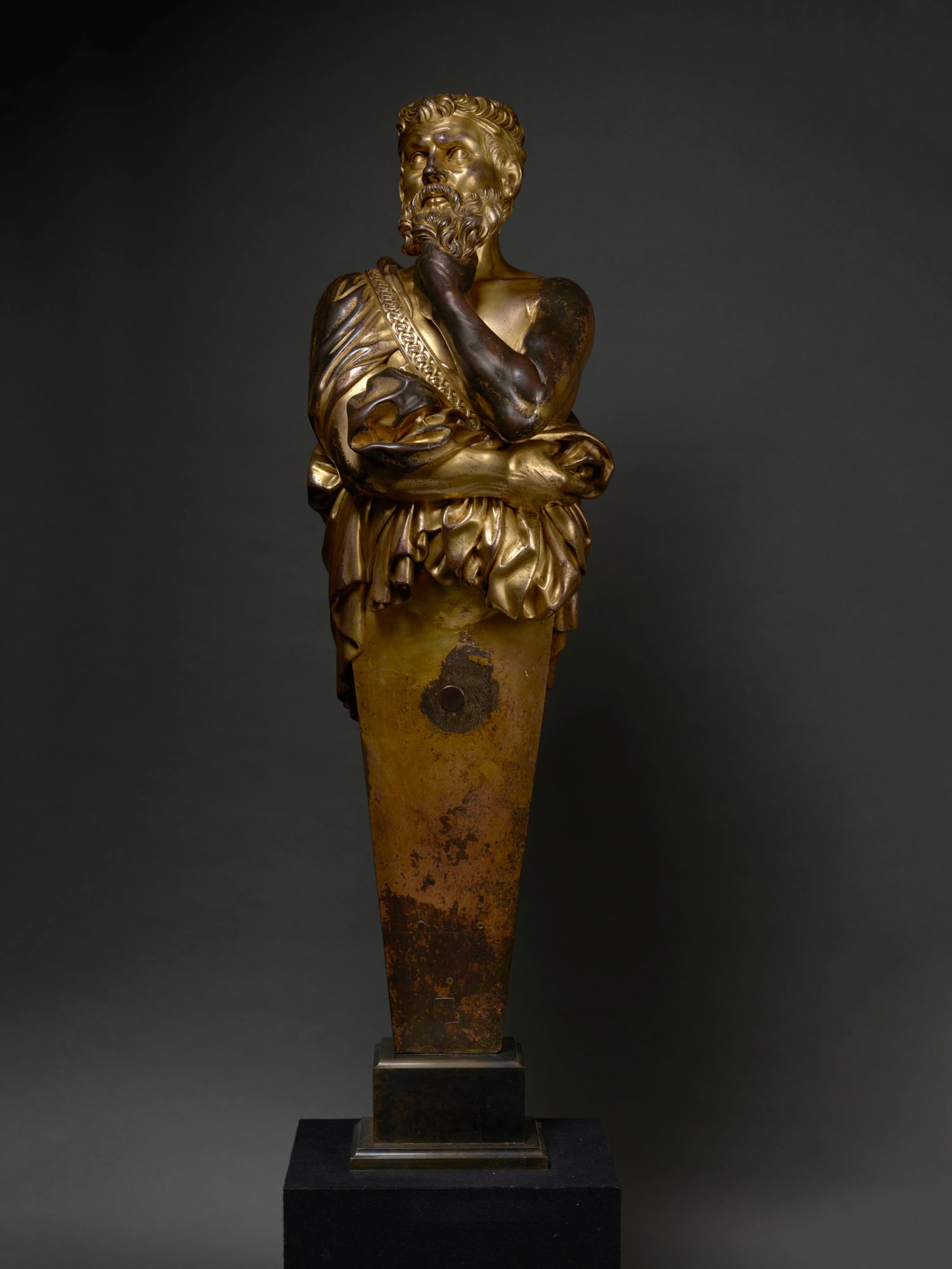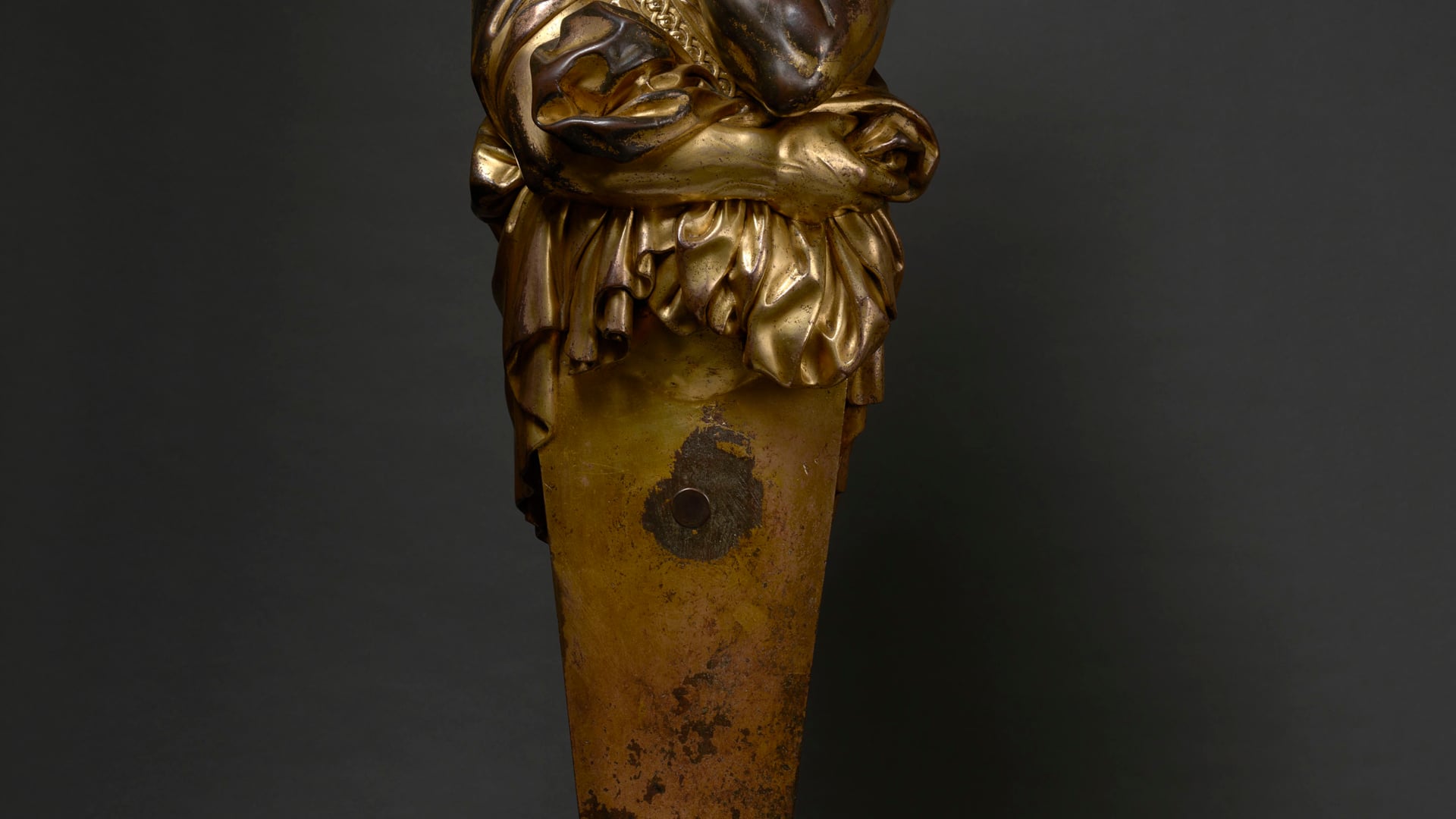

Likely acquired for Richmond House, London, by the Dukes of Richmond, Lennox and Aubigny
Collections of the Dukes of Richmond and Gordon, Goodwood House, West Sussex.
Francis Stonor, Stonor Park, Oxfordshire, acquired above
Collection of the Honourable Francis Stonor; Sotheby's sale, London, July 27, 1956, lot 69
Christie's sale, London, December 8, 1987, lot 175
Daniel Katz Gallery, London, 1988
Hubert de Givenchy (1927-2018)
His Sale; Hubert de Givenchy Collectionneur: Chefs-d'oeuvre | Masterpieces, Christie’s, Paris, 14 June 2022, lot 41
Collections of the Dukes of Richmond and Gordon, Goodwood House, West Sussex.
Francis Stonor, Stonor Park, Oxfordshire, acquired above
Collection of the Honourable Francis Stonor; Sotheby's sale, London, July 27, 1956, lot 69
Christie's sale, London, December 8, 1987, lot 175
Daniel Katz Gallery, London, 1988
Hubert de Givenchy (1927-2018)
His Sale; Hubert de Givenchy Collectionneur: Chefs-d'oeuvre | Masterpieces, Christie’s, Paris, 14 June 2022, lot 41
The Burlington House Fair, Burlington House, London, 12-21 March 1982
J. Musson, 'Stonor Park', in Country Life Magazine, 5 April 2001, pp. 80-85.
M. M. Reese, Goodwood's Oak: Life and Times of the Third Duke of Richmond and Lennox, London, 1987.
G. Zelleke, 'From Chantilly to Sèvres: French Porcelain and the Dukes of Richmond', in The French Porcelain Society, VII, 1991.
Betsy Rosasco, The Herms of Versailles in the 1680s in The Princeton University Library Chronicle, Vol. 76, No. 1-2 (Winter 2015), pp. 145-175 (31 pages)
M. M. Reese, Goodwood's Oak: Life and Times of the Third Duke of Richmond and Lennox, London, 1987.
G. Zelleke, 'From Chantilly to Sèvres: French Porcelain and the Dukes of Richmond', in The French Porcelain Society, VII, 1991.
Betsy Rosasco, The Herms of Versailles in the 1680s in The Princeton University Library Chronicle, Vol. 76, No. 1-2 (Winter 2015), pp. 145-175 (31 pages)
The present bronze caryatid figure once adorned a grand fireplace or architectural scheme within a royal or noble domestic setting. The figure’s pensive gaze, full beard and fillet in the hair all suggest that he is intended to represent an ancient philosopher, likely Plato. The bronze was previously owned by Francis Stonor, who amassed an important art collection including many bronzes during the decades that followed the Second World War. It passed to him from the collections of the Dukes of Richmond and Lennox, who had a long connection to France and French culture which began with the first Duke in the 17th century, who was the illegitimate son of Charles II of England and his French mistress Louise de Kerouaille and through lands which they held there into the 18th century.
The philosopher is a wonderful exemplar of French bronze mastery, perceptively modelled, beautifully cast, and elaborately chased and gilded. Given the quality, scale and finish it was undoubtedly intended to decorate an important French residence. Quite possibly of royal origin, it is exactly the type of feature that is typical of the taste of Versailles during the period of King Louis XIV (1638-1715). The link to Versailles and a potential royal heritage is furthered by parrallels that can be made between our figure and a statue of Winter at Versailles, by the great François Girardon (1628-1715) and also another statue, also at Versailles, and which bears even closer iconographical similarities to our bronze, depicting Plato by Joseph Rayol (1655-1718) based on a drawing by Pierre Mignard, and engraved by Simon Thomassin from his publication Recueil des Statues de Versailles 1695, (commissioned 1689). The possibility of earlier noble or royal French provenance prior to the bronze being acquired by the Dukes of Richmond and Lennox is still being investigated.
Jean le Pautre (1618-1682) produced the first herm designs for Versaille in the 1670s, and depicted in his Nouveau Livre des Terms, 1695, the frontispiece of which show similar bearded figures to the present work. The fashion for these sorts of decorative statues for the French court and nobility can be traced back beyond Le Pautre, to Jean Barbet (1591-before 1654), and his Livre d’Arhcitecture ’d'Autels et de Cheminées, of 1632, engraved by Abraham Bosse in which such terms feature quite heavily. Initially incorporated into elaborate doorway schemes known as Porte-cochère, they also began to feature as decorative elements in fireplaces. The interest in classically inspired caryatid figures within elaborate Porte-cochère decorative schemes in France can be traced back to Francis I (1494-1547) and his commission, conveyed in person, to Benvenuto Cellini in January 1542, for him to design a group of colossal bronzes to adorn the Porte Dorée at Fontainebleau; a monumental doorway that was to become the principal ceremonial entrance to the chateau.
The Dukes of Richmond and Lennox had a long connection to France and French culture which began with the first Duke, who was the illegitimate son of Charles II of England and his French mistress Louise de Kerouaille. She was created Duchess of Portsmouth and also had the title Duchesse d'Aubigny, a title which the present - 11th - Duke still retains. The Dukes had estates in France which they held until the Napoleonic era and the 2nd and 3rd Dukes in particular travelled regularly there and were important early patrons of French porcelain (see Zelleke, op. cit.). The 3rd Duke conducted a Grand Tour on the continent from 1752-1756 and was also briefly English Ambassador Extraordinary and Minister Plenipotentiary to the French court in 1765-66. He developed a strong interest in sculpture and amassed a collection which included plaster casts. He used these to form an artist’s academy at his London home, Richmond House in Whitehall, where 'any painter, carver, sculptor or other artist and youth over twelve years of age' could study under the direction of the sculptor Joseph Wilton and the painter Giovanni Cipriani (Reese, op. cit., p. 58, note 6). It would be logical that the present bronze figure formed part of this academy but was later transferred to the family's country seat, Goodwood House, possibly after Richmond House was badly damaged by fire in 1791.
It is not known exactly when Francis Stonor acquired the bronze but it was sold from his collection in a sale at Sotheby's London in 1956. Stonor, the great-grandson of the 3rd Lord Camoys of Stonor Park in Oxfordshire, was the owner of the tea emporium Jacksons of Piccadilly, and his personal wealth allowed him to indulge his passion for art. Starting in the 1940s, he acquired furniture, paintings and silver-gilt - mainly of the 18th century - which he housed in his flat in St John's Wood, north London. He also collected bronzes, many of which dated to the 16th century. At his death, Stonor had no direct heirs so the bulk of the collection was left to his cousin, the 7th Baron Camoys of Stonor Park, although as noted above, the present bronze caryatid had already left the collection.
The philosopher is a wonderful exemplar of French bronze mastery, perceptively modelled, beautifully cast, and elaborately chased and gilded. Given the quality, scale and finish it was undoubtedly intended to decorate an important French residence. Quite possibly of royal origin, it is exactly the type of feature that is typical of the taste of Versailles during the period of King Louis XIV (1638-1715). The link to Versailles and a potential royal heritage is furthered by parrallels that can be made between our figure and a statue of Winter at Versailles, by the great François Girardon (1628-1715) and also another statue, also at Versailles, and which bears even closer iconographical similarities to our bronze, depicting Plato by Joseph Rayol (1655-1718) based on a drawing by Pierre Mignard, and engraved by Simon Thomassin from his publication Recueil des Statues de Versailles 1695, (commissioned 1689). The possibility of earlier noble or royal French provenance prior to the bronze being acquired by the Dukes of Richmond and Lennox is still being investigated.
Jean le Pautre (1618-1682) produced the first herm designs for Versaille in the 1670s, and depicted in his Nouveau Livre des Terms, 1695, the frontispiece of which show similar bearded figures to the present work. The fashion for these sorts of decorative statues for the French court and nobility can be traced back beyond Le Pautre, to Jean Barbet (1591-before 1654), and his Livre d’Arhcitecture ’d'Autels et de Cheminées, of 1632, engraved by Abraham Bosse in which such terms feature quite heavily. Initially incorporated into elaborate doorway schemes known as Porte-cochère, they also began to feature as decorative elements in fireplaces. The interest in classically inspired caryatid figures within elaborate Porte-cochère decorative schemes in France can be traced back to Francis I (1494-1547) and his commission, conveyed in person, to Benvenuto Cellini in January 1542, for him to design a group of colossal bronzes to adorn the Porte Dorée at Fontainebleau; a monumental doorway that was to become the principal ceremonial entrance to the chateau.
The Dukes of Richmond and Lennox had a long connection to France and French culture which began with the first Duke, who was the illegitimate son of Charles II of England and his French mistress Louise de Kerouaille. She was created Duchess of Portsmouth and also had the title Duchesse d'Aubigny, a title which the present - 11th - Duke still retains. The Dukes had estates in France which they held until the Napoleonic era and the 2nd and 3rd Dukes in particular travelled regularly there and were important early patrons of French porcelain (see Zelleke, op. cit.). The 3rd Duke conducted a Grand Tour on the continent from 1752-1756 and was also briefly English Ambassador Extraordinary and Minister Plenipotentiary to the French court in 1765-66. He developed a strong interest in sculpture and amassed a collection which included plaster casts. He used these to form an artist’s academy at his London home, Richmond House in Whitehall, where 'any painter, carver, sculptor or other artist and youth over twelve years of age' could study under the direction of the sculptor Joseph Wilton and the painter Giovanni Cipriani (Reese, op. cit., p. 58, note 6). It would be logical that the present bronze figure formed part of this academy but was later transferred to the family's country seat, Goodwood House, possibly after Richmond House was badly damaged by fire in 1791.
It is not known exactly when Francis Stonor acquired the bronze but it was sold from his collection in a sale at Sotheby's London in 1956. Stonor, the great-grandson of the 3rd Lord Camoys of Stonor Park in Oxfordshire, was the owner of the tea emporium Jacksons of Piccadilly, and his personal wealth allowed him to indulge his passion for art. Starting in the 1940s, he acquired furniture, paintings and silver-gilt - mainly of the 18th century - which he housed in his flat in St John's Wood, north London. He also collected bronzes, many of which dated to the 16th century. At his death, Stonor had no direct heirs so the bulk of the collection was left to his cousin, the 7th Baron Camoys of Stonor Park, although as noted above, the present bronze caryatid had already left the collection.